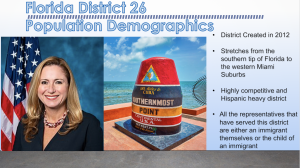
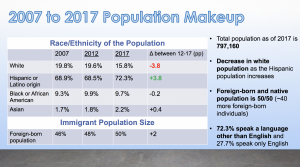
Slide 1: FL-26 is a Hispanic heavy district with 72.3% of the 2017 population identifying as Hispanic or Latino origin, 15.8% white, 9.7% Black or African American and 2.2% Asian. Within the Hispanic population, the majority of the district Hispanics are either Cuban (~39%) or from another Hispanic background (~23%) and about ~ 5% are Mexican, and ~4 are Puerto Rican. When comparing the population change in the district, I calculated the difference between 2012 (when the district was redrawn; FL-25 was the closest geographically for the 2007 figures) and 2017. Although, I think it’s important to note that there isn’t any significant difference between the 2007 and 2012 population demographics. The only significant change in those five years is a slight 3.8% decrease in the white population, and an equaled 3.8 increase in the Hispanic population. Now, when we look at the foreign-born and native population in the district, we see an upward trend in the foreign-born population. Currently, the district is evenly split (50/50) with about 40 more foreign-born individuals. This rate is more than double the 20.9% foreign-born rate in Florida and 13.% rate in the U.S.Of the foreign-born population, 94% come from Latin America. Within the foreign-born population, in both 2012 and 2017, around 58% are naturalized U.S. citizens which shows a significant increase from 2007 when about 49% were naturalized. I also looked at the languages spoken in the district, and found that 72.3% speak a language other than English (which means there either bilingual or monolingual of another language, most likely Spanish given the district demographics) and 27.7% only speak English.
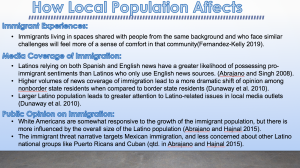
Slide 2: To look at how characteristics of the local population and the changes in these characteristics affect immigrant experiences, media coverage of immigration and public opinion on immigration, we turn to the literature. Fernandez-Kelly finds that immigrants living in spaces shared with people from the same backgrounds and who face similar challenges feel a sense of comfort in that community. We can expect to see in districts with large Latino populations more immigrant integration into the community, and the community will be reflective of this population as well, possibly with restaurants or festivals that celebrate the cultures of the immigrant community. When we look at the media Coverage of immigration, the language the news is covered in, the volume of the coverage, and the size of the Latino population are all factors to consider. Abrajano and Singh found that Latinos relying on both Spanish and English news have a higher likelihood of possessing pro-immigrant sentiments than Latinos who only use English news sources. When it comes to the volume of news coverage, among non border state residents like those in Florida, more immigrant news coverage leads to more dramatic shifts of opinion when compared to residents in border states (Dunaway et al. 2010). Dunaway also concludes that a larger Latino population leads to more considerable attention to Latino-related issues in local media outlets like immigration, which tends to be a synonym of being Hispanic or Latino. In regards to the effects on public opinion, Abrajano and Hajnal concluded that white Americans are somewhat responsive to the growth of the immigrant population, but there are more influenced by the overall size of the Latino population. They also cite research that finds that the immigrant threat narrative targets Mexican immigration, and is less concerned about other Latino national groups like Puerto Ricans and Cubans.
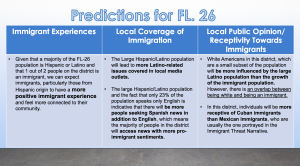
Slide 3: Based on the characteristics of the FL-26 population, we can predict that immigrants, particularly those from Hispanic/Latino origin will have a more positive immigrant experience and feel more connected to their community due to the mostly Hispanic and foreign-born population. The local coverage of immigration in this district is expected to feature more Latino-related issues like immigration. Also, given that only 23% of the population speaks only English and therefore will seek just English news, the remaining 72.3% of the district who speaks a language other than English, and given the district population characteristics probably speak Spanish, there will be more people seeking Spanish news. Given all of this, I would expect the majority of the people in the district to access news that features a more pro-immigrant sentiment. White Americans in this district, which are a small subset of the population will be more influenced by the large Latino population than the growth of the immigrant population. However, we must also note that there is an overlap between being white and being an immigrant in this district, so the influence probably won’t be so significant in this particular district. Also, in this district, individuals will be more receptive of Cuban immigrants than Mexican immigrants, who are usually the ones portrayed in the immigrant threat narrative.
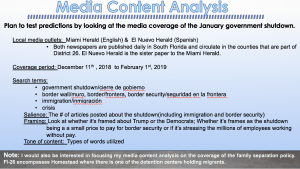
Slide 4: The prediction that I’m testing is that that given the large Hispanic/Latino population in FL-26 is indicative that the Spanish media coverage of the government shutdown will have a higher focus on immigration than the English media coverage of the shutdown. To do this, I plan to compare the media coverage of the January government shutdown in an English and Spanish local news outlet. I will examine the news coverage starting on December 11, 2018, when news outlets began to report that President Trump would shut down the government after a meeting with Pelosi and Schumer up until February 1st, 2019, a week after the government reopened. The local media outlets I’ve decided would be more fruitful to look at are the Miami Herald, which publishes daily in South Florida in English, and El Nuevo Herald, which also publishes daily but in Spanish. As you probably noted in the name, these newspapers are sister papers, but they target different audiences. Also, I considered looking at the news articles published online from Univision and an English news outlet like CBS Miami, so I would like to get your feedback on that. Additionally, I could also try to compare the news from the Heralds with Spanish and English news from a district similar to FL-26. To gather the media content, I’ll use the following search terms: government shutdown/cierre de gobierno, border wall/muro, border/frontera, border security/seguridad en la frontera, immigration/inmigración and crisis. To look at the salience of the coverage, I’ll calculate the # of articles posted about the shutdown and categorizes them by frame. I’ll look for the following frames that the coverage could have embraced: whether Trump or the Democrats are to blame for the shutdown, whether the shutdown is a small price to pay for border security or whether it was framed to stress the millions of government employees who were working without pay. For the tone of the content, I’ll focus on the types of words utilized in the articles. Although I think this is an interesting research plan that I would like to pursue, I will also be interested in focusing my media content analysis on the coverage of the family separation policy. Fl-26 encompasses Homestead where there is one of the detention centers holding migrants, so I would like to dive more into that kind of media coverage from Spanish and English news outlets.